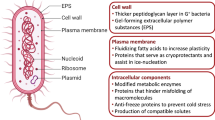Abstract
The Siberian permafrost is an extreme, yet stable environment due to its continuously frozen state. Microbes maintain membrane potential and respiratory activity at average temperatures of −10 to −12°C that concentrate solutes to an a w = 0.90 (5 osm), The isolation of viable Psychrobacter arcticus sp. 273-4 and Exiguobacterium sibiricum sp. 255-15 from ancient permafrost suggests that these bacteria have maintained some level of metabolic activity for thousands of years. Permafrost water activity was simulated using ½ TSB + 2.79 m NaCl (5 osm) at and cells were held at 22 and 4°C. Many cells reduced cyano-tetrazolium chloride (CTC) indicating functioning electron transport systems. Increased membrane permeability was not responsible for this lack of electron transport, as more cells were determined to be intact by LIVE/DEAD staining than were reducing CTC. Low rates of aerobic respiration were determined by the slope of the reduced resazurin line for P. arcticus, and E. sibiricum. Tritiated leucine was incorporated into new proteins at rates indicating basal level metabolism. The continued membrane potential, electron transport and aerobic respiration, coupled with incorporation of radio-labeled leucine into cell material when incubated in high osmolarity media, show that some of the population is metabolically active under simulated in situ conditions.




Similar content being viewed by others
References
Albers SV, Van de Vossenberg JL, Driessen AJ, Konings WN (2001) Bioenergetics and solute uptake under extreme conditions. Extremophiles 5:285–294
Bakermans C, Ayala-del-Rio HL, Ponder MA, Vishnivetskaya T, Gilichinsky D, Thomashow MF, Tiedje JM (2006) Psychrobacter cryohalolentis sp. nov. and Psychrobacter arcticus sp. nov., isolated from Siberian permafrost. Int J Syst Evol Microbiol 56:1285–1291
Bakermans C, Tsapin AI, Souza-Egipsy V, Gilichinsky DA, Nealson KH (2003) Reproduction and metabolism at −10°C of bacteria isolated from Siberian permafrost. Environ Microbiol 5:321–326
Brinton KLF, Tsapin AI, Gilichinsky D, McDonald GD (2002) Aspartic acid racemization and age-depth relationships for organic carbon in Siberian permafrost. Astrobiology 2:77–82
Buesing N, Gessner MO (2003) Incorporation of radiolabeled leucine into protein to estimate bacterial production in plant litter, sediment, epiphytic biofilms, and water samples. Microb Ecol 45:291–301
Carpenter EJ, Lin S, Capone DG (2000) Bacterial activity in South Pole snow. Appl Environ Microbiol 66:4514–4517
Christner BC (2002) Incorporation of DNA and protein precursors into macromolecules by bacteria at −15°C. Appl Environ Microbiol 68:6435–6438
Friedmann EI (1994) Permafrost as microbial habitat. Viable microorganisms in permafrost. D. Gilichinsky. Puschinio, Russian Academy of Sciences, pp 21–26
Gilichinsky D (1993) Viable microorganisms in permafrost: the spectrum of possible applications to investigations in science for cold regions. Fourth International symposium on thermal engineering and science for cold regions, Hanover, NH, US. Army Corp of Engineers
Gilichinsky D, Rivkina E, Shcherbakova V, Laurinavichuis K, Tiedje J (2003) Supercooled water brines within permafrost—an unknown ecological niche for microorganisms: a model for astrobiology. Astrobiology 3:331–341
Gilichinsky DA, Wagener S, Vishnevetskaya T (1995) Permafrost microbiology. Permafrost Periglacial Process 6:281–291
Gilichinsky DA, Wilson GS, Friedmann EI, McKay CP, Sletten RS, Rivkina EM, Vishnivetskaya TA, Erokhina LG, Ivanushkina NE, Kochkina GA, Shcherbakova VA, Soina VS, Spirina EV, Vorobyova EA, Fyodorov-Davydov DG, Hallet B, Ozerskaya SM, Sorokovikov VA, Laurinavichyus KS, Shatilovich AV, Chanton JP, Ostroumov VE, Tiedje JM (2007) Microbial populations in Antarctic permafrost: biodiversity, state, age, and implication for astrobiology. Astrobiology 7:275–311
Junge K, Eicken H, Deming JW (2004) Bacterial activity at −2 to −20 degrees C in Arctic wintertime sea ice. Appl Environ Microbiol 70:550–557
Karl DM, Bird DF, Bjorkman K, Houlihan T, Shackelford R, Tupas L (1999) Microorganisms in the accreted ice of Lake Vostok, Antarctica. Science 286:2144–2147
Krumbein WE, Gorbushina AA, Holtkamp-Tacken E (2004) Hypersaline microbial systems of sabkhas: examples of life’s survival in “extreme” conditions. Astrobiology 4:450–459
Litchfield CD (1998) Survival strategies for microorganisms in hypersaline environments and their relevance to life on early Mars. Meteorit Planet Sci 33:813–819
Ostroumov VE, Siegert C (1996) Exobiological aspects of mass transfer in microzones of permafrost deposits. Life Sci Space Mars Recent Results 18:79–86
Pewe T (1995) Permafrost. Encylopedia Britannica, pp 752–759
Ponder M (2005) Characterization of physiological and transcriptome changes in the ancient Siberian permafrost bacterium Psychrobacter arcticus 273-4 with low temperature and increased osmotica. Microbiology and molecular genetics. Michigan State University, East Lansing, p 215
Ponder MA, Gilmour SJ, Bergholz PW, Mindock CA, Hollingsworth R, Thomashow MF, Tiedje JM (2005) Characterization of potential stress responses in ancient Siberian permafrost psychroactive bacteria. FEMS Microbiol Ecol 53:103–115
Price PB, Sowers T (2004) Temperature dependence of metabolic rates for microbial growth, maintenance, and survival. Proc Natl Acad Sci USA 101:4631–6
Rand RP (2004) “Osmotic Stress Pressure Measurements.” Retrieved 11-6-07, 2007, from http://www.brocku.ca/researchers/peter_rand/osmotic/osfile.html
Rivkina EM, Friedmann EI, McKay CP, Gilichinsky DA (2000) Metabolic activity of permafrost bacteria below the freezing point. Appl Environ Microbiol 66:3230–3233
Rodrigues D, Goris J, Vishnivetskaya T, Gilichinsky D, Thomashow M, Tiedje J (2006) Characterization of exiguobacterium isolates from the Siberian permafrost. Description of Exiguobacterium sibiricum sp. nov. Extremophiles 10:285–294
Soina VS, Mulyukin AL, Demkina EV, Vorobyova EA, El-Registan GI (2004) The structure of resting bacterial populations in soil and subsoil permafrost. Astrobiology 4:345–358
Vishnivetskaya T, Kathariou S, McGrath J, Gilichinsky D, Tiedje JM (2000) Low-temperature recovery strategies for the isolation of bacteria from ancient permafrost sediments. Extremophiles 4:165–173
Acknowledgments
This research was funded by the National Astrobiology Institute of NASA. We thank Tatiana Vishnivetskaya for input based on preliminary physiological data which allowed us to focus on a narrower number of interesting permafrost isolated strains for further studies within our laboratory. We acknowledge the assistance of Chia-Kai Chang, Gisel Rodriguez, and Matt Campbell. We thank Richard Lenski and Corien Bakermans for strains E.coli 606 and P. cryohalolentis, respectively.
Author information
Authors and Affiliations
Corresponding author
Additional information
Communicated by K. Horikoshi.
Rights and permissions
About this article
Cite this article
Ponder, M.A., Thomashow, M.F. & Tiedje, J.M. Metabolic activity of Siberian permafrost isolates, Psychrobacter arcticus and Exiguobacterium sibiricum, at low water activities. Extremophiles 12, 481–490 (2008). https://doi.org/10.1007/s00792-008-0151-0
Received:
Accepted:
Published:
Issue Date:
DOI: https://doi.org/10.1007/s00792-008-0151-0




